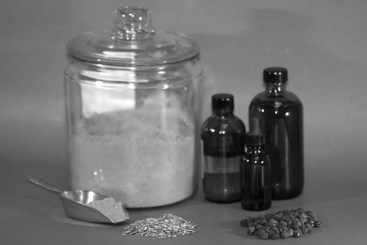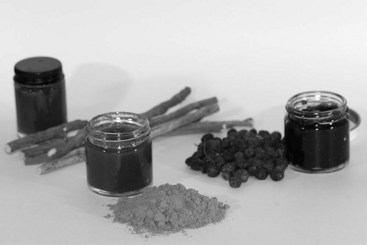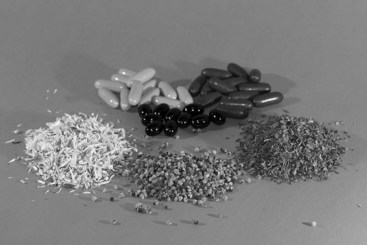CHAPTER 19 Nutritional, Herbal, and Homeopathic Supplements
Description
Terminology and Subtypes
The United States Dietary Supplement Health and Education Act of 1994 defines a nutritional supplement as “a product (other than tobacco) that is intended to supplement the diet that bears or contains one or more of the following dietary ingredients: a vitamin, a mineral, an herb or other botanical, an amino acid, a dietary substance for use by man to supplement the diet by increasing the total daily intake, or a concentrate, metabolite, constituent, extract, or combinations of these ingredients” (Figure 19-1).1 The equivalent legislation in Canada is the Natural Health Products (NHPs) Regulations, which defines an NHP as a natural source “substance that is manufactured, sold, or represented for use in: (1) the diagnosis, treatment, mitigation, or prevention of a disease, disorder or abnormal physical state or its symptoms in humans; (2) restoring or correcting organic functions in humans; or (3) modifying organic functions in humans, such as modifying those functions in a manner that maintains or promotes health.”2
Nutritional supplements are often associated with complementary and alternative medicine (CAM), which encompasses a group of diverse medical and health care systems, practices, and products that are not considered part of conventional medicine.3 The main types of nutritional supplements that will be discussed in this chapter are herbal medicines, vitamins, minerals, and homeopathic remedies. The use of other supplements, such as accessory nutrients (e.g., coenzyme Q10), macronutrients (e.g., fatty acids, amino acids), and other macromolecules (e.g., glucosamine, bee pollen) are not reviewed in the chapter. Nutritional supplements are also termed dietary supplements or supplements.
Herbal Medicines
Herbal medicines, also called herbal medicinal products, are a diverse group of heterogeneous substances and products that can be delivered in a number of ways, including as whole herbs, herbal materials, herbal preparations, and finished herbal products that contain, as active ingredients, plants or plant materials. The term herbal medicine excludes single compounds that are derived and purified from plants or synthesized in laboratory settings.4 By definition, herbal medicines are used for medicinal purposes and may be taken by oral ingestion, injection, or applied topically. Oral herbal medicines include raw plant material (dried or fresh), liquid extracts (with alcohol, aqueous, or glycerin solvents), and solid extracts (e.g., lyophilized or freeze dried) (Figures 19-2 and 19-3). Some forms of herbal medicine are given via intramuscular (IM) or intravenous routes. Topical forms include creams, gels, ointments, oils, plasters, and poultices.

Figure 19-2 Herbal supplements as dried plant materials and liquid plant extracts.
(Photo by Martin Wall Photography.)
Vitamins and Minerals
Vitamins are a group of substances essential for normal metabolism, growth, development, and regulation of cell function. They work together with enzymes, cofactors (substances that assist enzymes), and other substances necessary for normal bodily functions. The two main types of vitamins are fat-soluble (e.g., vitamins A, D, E, K) and water-soluble (e.g., vitamins B and C). Minerals are similarly defined as a group of substances essential for normal metabolism, growth, development, body structure, cell function regulation, and electrolyte balance. The two main types of minerals are macrominerals (e.g., calcium, phosphorus, sodium) and trace minerals (e.g., zinc, selenium, manganese).5 There are many forms of vitamins and minerals as well as many routes of administration. For example, vitamin C can be manufactured as ascorbic acid or ascorbate, and calcium is available as calcium carbonate, calcium citrate, or calcium lactate. Vitamin and mineral supplements are frequently mixed with other vitamins, minerals, or herbal medicines that are thought to enhance their action. Different types of vitamins and minerals can be compounded in a variety of ways, including as capsules, tablets, liquids, gels, or creams (Figure 19-4).
Homeopathic Remedies
Homeopathy is a system of healing established by Samuel Hahnemann two centuries ago that is founded on the “law of similars” (similia similibus curentur). This principle states that if a substance is capable of inducing a series of symptoms in a healthy living system, microscopically low doses of the same substance can also be used to cure those same symptoms under certain circumstances.6 Homeopathic supplements are generally termed remedies and can be made from virtually any naturally occurring substance (e.g., herbal, animal, mineral). Thousands of homeopathic remedies are in existence, each of which may come in different potencies. In this context, potency refers to the relative strength of homeopathic remedies. Unlike conventional chemical potency, homeopathic potency is thought to be greatest when it has gone through a higher number of serial dilutions. The number of serial dilutions is indicated by a digit and a letter, where X = 1/10 dilution, C = 1/100 dilution, M = 1/1000 dilution, and LM = 1/50,000 dilution (e.g., 5X = 5 serial 1/10 dilutions, or 1/100,000).7 Homeopathic remedies can be delivered as liquids, tablets, creams, gels, or sprays and can be made up of single or multiple ingredients (Figure 19-5).
History and Frequency of Use
Herbal Medicines
Herbal medicines have been used throughout written history, and probably even longer. Archaeological evidence suggests the use of herbal medicines for various conditions as early as 60,000 years ago.8 More recently, the use of specific extracts of herbal medicines was popular in the United States and Canada from the nineteenth century until the 1930s before slowly falling out of favor with the advent of modern pharmaceuticals. Resurgence was noted in the 1970s when studies from several European countries (most notably Germany) began applying scientific principles to testing the use of herbal medicines in clinical settings. Preclinical and clinical research on this topic has been increasing at a staggering rate in recent years.
Vitamins and Minerals
Early theories on the cause of beriberi—a condition caused by severe vitamin B1 (thiamine) deficiency—implicated the formation of toxins following improper cooking, preservation, or storage of food. However, experiments using standardized food suggested the existence of accessory factors that were essential for metabolic processes and could not be synthesized by an organism. In 1912, Cashmir Funk named these accessory factors “vitamines” because they were considered vital amines (thiamine from rice husks contained nitrogen, almost called amine at the time). The term was later changed to vitamin when scientists from 1912 to 1948 identified, purified, and synthesized all of the vitamins and noted that they did not all contain amines.9 The importance of minerals to cell structure and function can be traced back to experiments that measured the specific mineral contents of tissues and fluids.10 Once minerals were identified and measured, research was undertaken to explore their specific functions and utility in the prevention and treatment of various clinical conditions.
Homeopathic Remedies
Homeopathy was founded by Samuel Hahnemann, a German physician, in 1796 when he first published a work describing the “law of similars” built upon observations made after administering various substances to healthy individuals.6 Such studies are known as provings in homeopathy and involve carefully recording all symptoms experienced after ingesting large quantities of herbal, animal, or mineral substances. Once raw materials are identified that can produce specific symptoms, they are serially diluted and administered to patients complaining of those same symptoms. There has been a large amount of research to improve the incomplete scientific understanding of homeopathic remedies.6
Use of Supplements
The use of nutritional supplements appears to be gaining popularity in recent years as increasing numbers of people with chronic low back pain (CLBP) seek CAM. A survey of CAM use among the general adult population of the United States conducted in 1991, reported that herbal medicine had been used by 3% of respondents in the past year, megavitamin therapy by 2%, and homeopathy by 1%.11 However, only 10% of those who reported using herbal medicine had consulted with a health care provider; similar figures were 12% and 32% for megavitamin therapy and homeopathy, respectively. When this survey was repeated in 1997, the use of herbal medicine in the previous 12 months had grown dramatically to 12%, whereas megavitamin use was 6%, and homeopathy use was 3%.11 Herbal medicine was the second most common CAM therapy after relaxation (16%). The proportion of users who saw a professional practitioner increased to 15% for herbal medicine, 24% for megavitamin therapy, and 17% for homeopathy. The total number of visits to practitioners for these interventions in 1997 was estimated at 10 million, 22 million, and 2 million, respectively. The medical conditions for which herbal medicine use was highest included allergies and insomnia; megavitamin use was highest for high blood pressure.
A prospective study of CAM use among 1342 patients with low back pain (LBP) who presented to general practitioners in Germany reported that 3% received homeopathy, less than 2% saw a naturopathic healer, and less than 1% used herbal medicine in the subsequent 1 year follow-up.12 The use of homeopathy was statistically significantly higher among females, with an odds ratio of 2.8 (95% confidence interval, 1.3 to 6.1). The Baseline Natural Health Products Survey conducted in 2005 found that 71% of Canadians had used an NHP at least once in the past year.13 LBP is one of the most commonly reported indications for CAM use. A survey in Canada reported that 37% of those with LBP visited a CAM practitioner, compared with only 17% in the general population.14 The number of randomized controlled trials (RCTs) related to CAM has been doubling every 5 years; the Cochrane Collaboration Complementary Medicine field contains more than 6500 studies.15 In addition, principles of CAM are now incorporated into some undergraduate medical education programs.16
Procedure
In their simplest forms, these interventions consist of patients using self-prescribed supplements purchased in health food stores, pharmacies, or grocery stores based on the advice of friends, family, or advertisements. Patients who consult with health care providers who do not specialize in these interventions (e.g., most primary care providers) may receive generic advice to follow manufacturer recommendations and avoid known drug interactions. Alternatively, patients may consult with health care providers who specialize in CAM interventions and supplements, including naturopaths, homeopaths, and some chiropractors, or physicians who undergo additional training. Before prescribing specific products, these providers will typically conduct a history and physical examination to arrive at a diagnosis that will inform their choice of specific supplements, doses, and instructions for use. Follow-up visits may be required to monitor response to care and adjust the type, frequency, or dose of recommended supplements. Although many individuals use supplements without any guidance, the number of visits to CAM providers has been rapidly increasing in North America.17
Regulatory Status
Nutritional supplements are regulated by the US Food and Drug Administration (FDA) under the Dietary Supplement Health and Education Act of 1994 (DSHEA). Broadly speaking, this legislation places the responsibility on the manufacturer to ensure that a dietary supplement is safe before it is marketed; no evidence is required to support its efficacy, as is currently the case with over-the-counter and prescription medications.18 Manufacturers of dietary supplements are generally not required to register their products with the FDA before marketing. Once sold to the public, the FDA is responsible for taking action against manufacturers if their products are unsafe or make false claims in advertising (e.g., that they can be used to treat a specific medical condition).
Theory
Mechanism of Action
Herbal Medicines
Several herbal medicines have been used for pain relief, including Commiphora molmol, Capsicum frutescens, Salix alba, Melaleuca alternifolia, Angelica sinensis, Aloe vera, Thymus officinalis, Menthe piperita, Arnica montana, Curcuma longa, Tanacetum parthenium, Harpagophytum procumbens, and Zingiber officinale, among others.19 Many of these herbal medicines have been the subject of extensive biochemical research in recent decades to understand their biochemical and pharmacologic properties.20 When studied, herbal medicines are often found to contain a variety of active compounds that exhibit different properties. This may help explain why some herbs have been used for so many different indications.
For example, Z. officinale has traditionally been used not only for musculoskeletal conditions such as arthritis, soft tissue injuries, and LBP, but also for gastrointestinal indications such as constipation, indigestion, and vomiting, as well as infection, hypertension, and dementia.21 Isolated components of Z. officinale were reported to have anti-inflammatory, antiemetic, antilipidemic, antioxidant, and immune modulation properties. One or more of these effects may be related to its use for CLBP; the same observation likely holds true of other herbal medicines (Table 19-1).
TABLE 19-1 Herbal Medicines Commonly Used for Chronic Low Back Pain
| English Name | Latin Name |
|---|---|
| Myrrh | Commiphora molmol |
| Cayenne | Capsicum frutescens |
| White willow | Salix alba |
| Tea tree | Melaleuca alternifolia |
| Dong quai | Angelica sinensis |
| Aloe | Aloe vera |
| Thyme | Thymus officinalis |
| Peppermint | Menthe piperita |
| Wolf’s bane | Arnica montana |
| Curcumin | Curcuma longa |
| Feverfew | Tanacetum parthenium |
| Devil’s claw | Harpagophytum procumbens |
| Ginger | Zingiber officinale |
Vitamins and Minerals
Various vitamins and minerals have been proposed as beneficial for musculoskeletal conditions such as CLBP. These include vitamins B1, B6, B12, and C, as well as the minerals zinc and manganese, among others. These substances are known to regulate various biochemical reactions in the body and their specific mechanisms of action on musculoskeletal tissues have been elucidated for many of these substances. In some cases vitamin and mineral supplements may be beneficial because they rectify insufficient levels obtained from a normal diet and they may also produce pharmacologic effects when ingested in quantities beyond normal daily allowances. For example, several vitamins and minerals, at normal daily intakes, play a role in the development and repair of connective and muscle tissue, including vitamin C, zinc, manganese, and biotin.22
Stay updated, free articles. Join our Telegram channel

Full access? Get Clinical Tree












